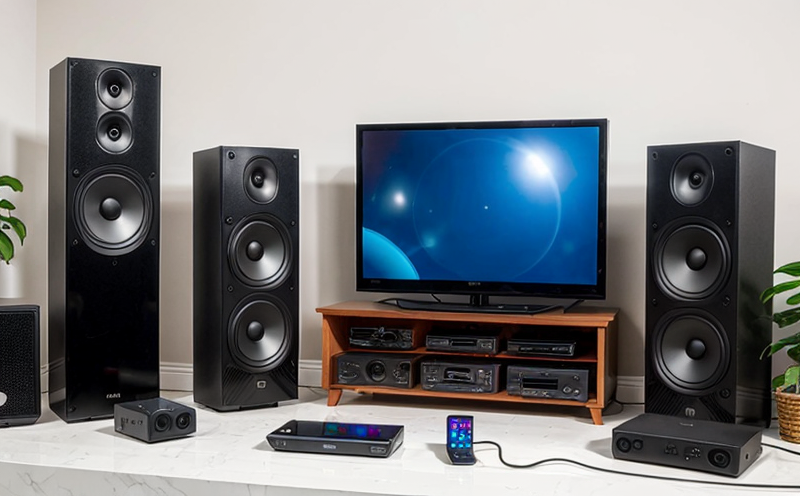UL 1310 Consumer AV Power Supply Safety Testing
The UL 1310 standard is a critical component of consumer audio/visual (A/V) device safety testing. This service ensures that power supplies used in A/V devices meet stringent safety requirements to protect users from electrical hazards such as shocks, fires, and other risks associated with improper design or manufacturing.
UL 1310 covers a wide range of consumer electronics including televisions, soundbars, home theater systems, video cameras, and more. Compliance with this standard is essential for manufacturers to ensure their products are safe for use in the home environment. This service is particularly important as it helps companies avoid costly recalls and potential legal issues.
The UL 1310 testing process involves several key steps aimed at identifying and mitigating risks associated with power supply design. During specimen preparation, engineers ensure that the units under test are representative of the production run, thus providing accurate results. The actual testing phase involves a series of rigorous procedures designed to simulate real-world conditions and assess performance.
One of the most significant aspects of this service is its focus on preventing electrical hazards. This includes evaluating insulation resistance, creepage and clearance distances, and ensuring proper grounding. Additionally, UL 1310 addresses protection against overvoltage, overheating, and other potential failures that could lead to accidents.
The testing process also involves assessing the durability of components under stress conditions. This helps manufacturers identify any weaknesses in their designs early on, allowing for necessary adjustments before products reach market shelves. By adhering strictly to these guidelines, companies can enhance product reliability and customer satisfaction.
| Aspect | Description |
|---|---|
| Insulation Resistance | Evaluates the ability of an insulator to prevent current flow, ensuring it meets minimum resistance values. |
| Creepage and Clearance Distances | Determines the shortest path between conductors or from a conductor to ground, providing protection against short circuits. |
| Grounding | Ensures proper connection of the power supply’s metal chassis to earth, reducing risk of electric shock. |
| Overvoltage Protection | Tests the ability of a device to withstand unexpected increases in voltage without failing or causing harm. |
| Thermal Management | Evaluates the effectiveness of heat dissipation mechanisms, ensuring they function correctly under various operating conditions. |
Scope and Methodology
- Insulation Resistance: Measures the resistance of materials used to isolate live parts from other conductors.
- Creepage and Clearance Distances: Ensures there is sufficient space between different electrical components to prevent short circuits.
- Grounding: Checks the integrity of grounding connections to ensure safety against electric shocks.
- Overvoltage Protection: Tests for effective protection against voltage spikes that could damage components or pose a risk.
- Thermal Management: Evaluates heat dissipation methods and their effectiveness in maintaining safe operating temperatures.
Quality and Reliability Assurance
Ensuring consistent quality and reliability is paramount for any manufacturing process. At our laboratory, we employ robust procedures to maintain high standards throughout the entire testing cycle. Our team adheres strictly to international standards such as UL 1310 to guarantee accurate and reliable results.
- Strict Compliance: All tests are conducted according to the latest versions of relevant standards.
- Precision Instruments: Utilize state-of-the-art equipment calibrated regularly to ensure accuracy.
- Trained Personnel: Our staff undergo continuous training to stay updated on best practices and new developments in the field.
- Repeatability: Multiple samples are tested to confirm consistent results, reducing variability due to anomalies or outliers.
International Acceptance and Recognition
The UL 1310 standard enjoys widespread recognition across the globe. It is widely accepted by governments, regulatory bodies, and industry leaders as a benchmark for power supply safety in consumer electronics.
Countries like the United States, Canada, and parts of Europe have adopted this standard due to its stringent requirements for protecting consumers from potential hazards. Compliance with UL 1310 not only enhances brand reputation but also opens doors to international markets where these standards are enforced.
Manufacturers who adhere to this standard can expect several benefits beyond mere compliance, including enhanced product safety, increased customer trust, and improved market access. These advantages translate into better consumer acceptance and higher sales volumes, making it a valuable asset for any company in the electronics industry.





